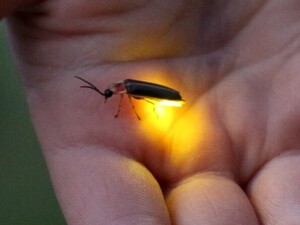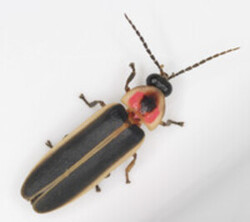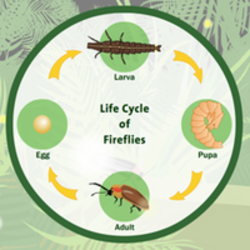Common Eastern Firefly (Photinus pyralis)
Photinus pyralis, also commonly referred to as the Common Eastern Firefly, Big Dipper Firefly, or Lightning Bug are a species of flying beetles that are one the most common firefly species in North America [1]. These beetles are known for the show they put on in the late summer and into the summer months.

Taxonomy
Kingdom: Animalia
Phylum: Anthropoda
Class: Insecta
Order: Coleoptera
Family: Lampyridae
Genus: Photinus

Description
The average adult beetle is around 9 to 19 mm (0.4 to 0.7 inches) long [1] consisting of three main sections including the head, thorax and abdomen. The overall body of the beetles transitions from red to black to yellow when analyzing from the head to the lower abdomen. The shield like plate covering the beetles head has a black dot in the center with surrounded by red and yellow with yellow on the outer most edge of the cover [2]. The wing covers are a black in color that is edged in yellow. Underneath the wing covers is pairs of wings and an abdomen that is black in color with respect to the last segment of the abdomen that is yellow. The last segment is the bioluminescent organ found to "glow". The beetles are found to have a hard exoskeleton with 6 jointed legs, two antennas, and compound eyes located on either side of the head [3] all of which are blackish brown in color. Each firefly species is found to have different lightning patterns. The male Common Eastern Firefly is found to have a single sustained yellow light while flying upwards forming the letter "J" [4]. The female fireflies are often found on long blades of grass emitting their own flashing signal to find a mate.
Habitat
These beetles are nocturnal and crepuscular indicating they are most active at night and during dawn and dusk. The larvae can be found living on damp ground near streams. The adult beetles are typically found in meadows, wetlands, and edges of woodlands typically found in conditions of wet soils and tall grasses [3].
Ecosystem Importance
The Common Easter Firefly acts as both a predator and prey.

Life Cycle
The Common Eastern Firefly geos through the life cycle of metamorphous as the beetle transforms from larvae to the adult beetle.
Eggs: Are about 1 mm in length and spherical in shape are found to hatch 4 weeks after being laid. It may also be found that the eggs emit a soft glow [1].
Larva: The larvae live around 1 to 2 years. The larvae may be found eating insects, snails, and earthworms [5].
Pupa: Pupas are formed as the larvae metamorphize to the adult phase. Pupates are found within damp soil requiring 9 to 15 days to fully mature which is dependent on soil temperatures [6].
Adult: The adult fireflies live around 30 days. A firefly may lay up to 500 eggs on damp soil[1].
References
[1] https://www.inaturalist.org/taxa/129350-Photinus-pyralis
[4] https://www.nps.gov/grsm/learn/nature/firefly-flash-patterns.htm